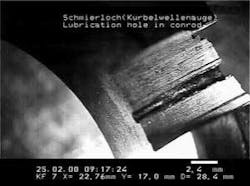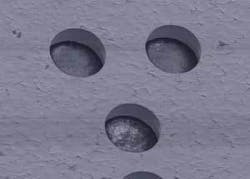Power drilling
Laser and process development drive hole drilling capability and quality
Keng Leong
Recent innovations in laser technology have resulted in the availability of robust lasers with a wide range of pulse and power capabilities. This article provides an updated overview of pulsed solid-state lasers suitable for manufacturing applications. A brief review of laser applications in drilling is followed by a discussion of the different types of lasers used and the requirements for robust and precise drilling applications. New lasers and capabilities are included to provide a potential laser user with the basis to evaluate the appropriate lasers for a particular drilling application.
In the early days of the technology pulsed ruby lasers and long-pulse Nd:glass lasers were used commercially for hole drilling. These were followed by the flashlamp-pumped Nd:YAG laser in the early 1970s and the introduction of the first robust high-performance pulsed Nd:YAG laser producing 1J/pulse in 1976 by Quanta-Ray. The JK Laser (later Lumonics and now GSI Group) pulsed Nd:YAG laser with pulse shaping followed in the 1980s and evolved to be one of the most successful industrial drilling lasers developed with more than 280 sold for mainly aerospace drilling applications. Other applications include drilling of deep angled holes for oil feed and connector rod scribing. Recently, higher peak power pulsed Nd:YAG lasers like the Convergent Prima P-50 were introduced. LASAG introduced its own version with pulse modulation capabilities for improved hole shape. Most systems are available with flexible fiber delivery and the recently introduced JK300D (GSI Group) offers high peak power.
Today, there is a wide range of lamp- and diode-pumped solid-state pulsed lasers for drilling. Pulsed gas lasers such as CO2, copper vapor, and excimer lasers offer additional alternatives. This discussion is confined mainly to diode-pumped solid-state lasers that are a more recent development. Diode-pumping offers improved pointing stability, higher pulse repetition rate, smaller footprint, and more robust operation than lamp pumping although pulse energies are substantially lower. Hence, they are the lasers of choice for high-speed precision drilling particularly for micromachining applications.
Table 1 lists the different types of diode-pumped solid-state lasers available with the lamp-pumped millisecond Nd:YAG for comparison. Pulse widths range from femtoseconds (fs) to milliseconds (ms) and pulse energies can be as high as tens of millijoules (mJ) with diode-pumping compared to 150J for lamp-pumped systems. The diode-pumped lasers are only listed in the fundamental frequency. Shorter wavelengths are available through frequency doubling, tripling, and quadrupling with approximately 50 percent efficiency for each step. Such wavelengths may have a higher absorption by particular materials and some advantages such as lower heat affected zone (HAZ). In general, the higher pulse energies are available for the longer wavelengths and deeper penetrations can be produced. Only lasers with multi-kHz repetition rates are included as they are favored for high throughput applications. Versions with low repetition rates are available with higher pulse energies that may result in deeper penetrations. A sampling of laser suppliers for the different pulsed lasers is listed in Table 2.
Drilling basics
The simplest way to drill a hole is to send focused laser pulses to the same position on the workpiece in what is commonly termed percussion drilling. This method is used mainly for drilling holes with the diameter of the focused spot. Trepanning is used to make holes larger than the spot size of the focused beam. In the approach, a hole is drilled through the workpiece then rotated so the appropriate sized hole is cut out. A variation of this method is by tracing the outline of the hole to be cut by either rotating the beam or the workpiece. The cut spirals into the material as the beam is rotated, hence the term helical drilling.
The basic laser parameters that determine whether the focused beam will drill or cut are the pulse irradiance and the pulse duration. Irradiance is the pulse energy divided by the focused spot area. These determine whether the absorbed energy will melt and vaporize the material or be conducted away to the surroundings causing a HAZ. The size of the HAZ is related to the pulse duration and thermal conductivity of the material. The process regime (heating, melting, or vaporization) is determined by the length of time of the irradiance applied (see Figure 1).1
For irradiance values of ~1MW/cm2 and pulse widths of ~1ms, melting dominates and there is less vaporization. However, with sufficient pulse energy, ejection of the melted mass can occur resulting in hole drilling. For such conditions, the HAZ is ~1mm and recast layer is slightly smaller. With tens of Joules available per millisecond pulse, high aspect ratio holes can be drilled as is done routinely in aerospace applications. Figure 2 shows an oil feed hole in a connector rod drilled by millisecond pulses. As evident from Figure 1, to decrease the HAZ and the recast or to improve the quality of the holes drilled, increase the irradiance and shorten the pulse length or interaction time. Hence, Q-switched lasers with pulsewidths on the order of 10 nanoseconds (ns) producing irradiances of ~1GW/cm2 can provide higher quality drilled holes. Because of the stability of diode-pumping and their high repetition rates, these lasers are ideal for high throughput micromachining where the low pulse energy limits the depth of drilling to a few mm.
Figure 3 shows high aspect ratio test holes drilled by 100ns pulses using a Nd:YLF laser. The process is being used to produce apertures in gas detection sensors. With high beam intensity, difficult materials such as carbon and plastics can be drilled with minimal HAZ. With the advent of femtosecond and picosecond (ps) lasers, the recast and HAZ results tend to be negligible. Figure 4 illustrates the high quality of holes drilled by ps pulses in molybdenum. This process has been implemented in the production of apertures.
Process quality
Process development and optimization are required to produce quality holes even for femtosecond lasers. Extremely high irradiances (>1015 W/cm2) can be produced with femtosecond pulses, but nonlinear effects that are absent in vacuum can be significant in ambient air affecting process quality. Consequently, pulse energy needs to be constrained to limit such nonlinear effects.2 In practice, low pulse energies <100 J and high repetition rates >10kHz are needed for good throughput. The recent introduction of a femtosecond fiber laser by PolarOnyx, for example, addresses this need. Similarly, process optimization is needed for picosecond lasers which can produce similar process quality as femtosecond lasers. With lower cost, higher power and repetition rate (compared to femtosecond lasers), picosecond lasers seem to be the laser of choice for many precision micromachining applications although femtosecond lasers may still be superior in some areas particularly in processing transmissive materials.As the pulses become longer, HAZ and recast become more significant and more elaborate process development is required to achieve the best quality. For example, helical drilling3 with optimized parameters is used and recently, double pulsing with microsecond (μs) pulses.4 In addition to optimizing the pulse irradiance and repetition rate, increasing the pulse energy as the hole drilling progresses has been shown to reduce hole taper in percussion drilling.5 With the limited pulse energy available for most high repetition rate diode-pumped lasers, the penetration is limited to a few millimeters. Deep penetration is still the realm of ms-pulse lasers with tens of J available per pulse. Pulse shaping and control of pulse energy and repetition rate are used to limit the size of the recast and HAZ.
Many choices
The potential user today has a wide array of pulsed lasers to consider for drilling. The optimal system will be determined by many parameters including the size and aspect ratio of the holes, quality required, speed of process, capital and operating costs, and system reliability. With the continual advancement in laser technology, pulse energy, repetition rate, and power are increasing. Innovations in technology are driving down capital costs and process improvements and developments are increasing the quality of holes drilled.
References
- K.H. Leong, (2004) “Evolving laser processing,” Industrial Laser Solutions, January, 17-19.
- K.H. Leong, A.A. Said, and R. L. Maynard, (2001) “Femtosecond micromachining of electro-optic components,” 51st Electronic Components & Technology Conference, May 29-June 1, Lake Buena Vista, Florida.
- Friedrich Dausinger, (2000) “Drilling of High Quality Micro Holes,” ICALEO 2000, Section B pp. 1-10.
- A.C. Forsman, et al., (2005) “Double-Pulse Machining as a Technique for the Enhancement of Material Removal Rates in Laser Machining of Metals,” Journal of Applied Physics, 98(1), 1-6. D.
- K. Y. Low, et al., (2000) “Combined Spatter and Hole Taper Control of Nd:YAG Laser Percussion Drilling,” ICALEO 2000, Section B pp. 11-20.






